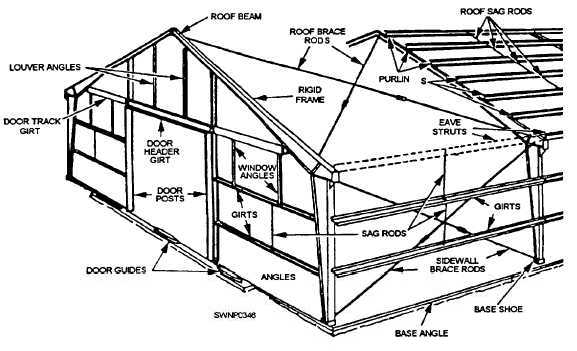Panels and miscellaneous parts, which will not be used immediately, should be placed on each side of the foundation on pallets or skids and covered with tarps or a similar type of covering until needed. Parts, making up the rigid-frame assemblies, are laid out ready for assembly and in position for raising.
Care should always be used in unloading materials. Remember that damaged parts will cause delays in getting the job done. To avoid damage, lower the materials to the ground slowly and do not drop them.
Figure 8-3 will help you identify the structural members of the building and their location. Each part has a specific purpose and must be installed in the location called for to ensure a sound structure. NEVER OMIT ANY PART CALLED FOR ON THE DETAILED ERECTION DRAWINGS. Each of the members, parts, and accessories of the building is labeled by stencil, so it is not necessary to guess which one goes where. Refer to the erection plans to find the particular members you need as you work.
ERECTION PROCEDURES
With all pre-erection work completed, inspected, and passed by Quality Control, as well as your inventory completed, you are ready to start erecting the P.E.B. This phase of our discussion will introduce you to the basic erection procedures. The reason for these instructions is to give you a general guide to follow. Keep in mind that the drawings provided by the manufacturer must be followed in all cases, even where the they might differ from information in this training manual. The manufacturer's standard practice is to always pack an erection manual and a set of drawings in the small parts box (Box 1) shipped with each building.
Bolting Rigid Frames
Before bolting up the rigid-frame assembly, clean all the dirt and debris from the top of the foundation, Then lay out and bolt the base shoes firmly to the concrete, using the 5/8-inch black steel washers between the shoes and the nuts. Lay out an assembled column and roof beam at each pair of base shoes (fig. 8-4), using one 3/4-inch by 1 l/2-inch bolt on each side of each base shoe to act as pivots in raising the frame. Use driftpins, if necessary, to line up the holes.
Frame Erection
A gin pole (chapter 6) can be used to raise the end frame of the building. To prevent distortion of the

Figure 8-3. - Structural members of a pre-engineered building.
Continue Reading